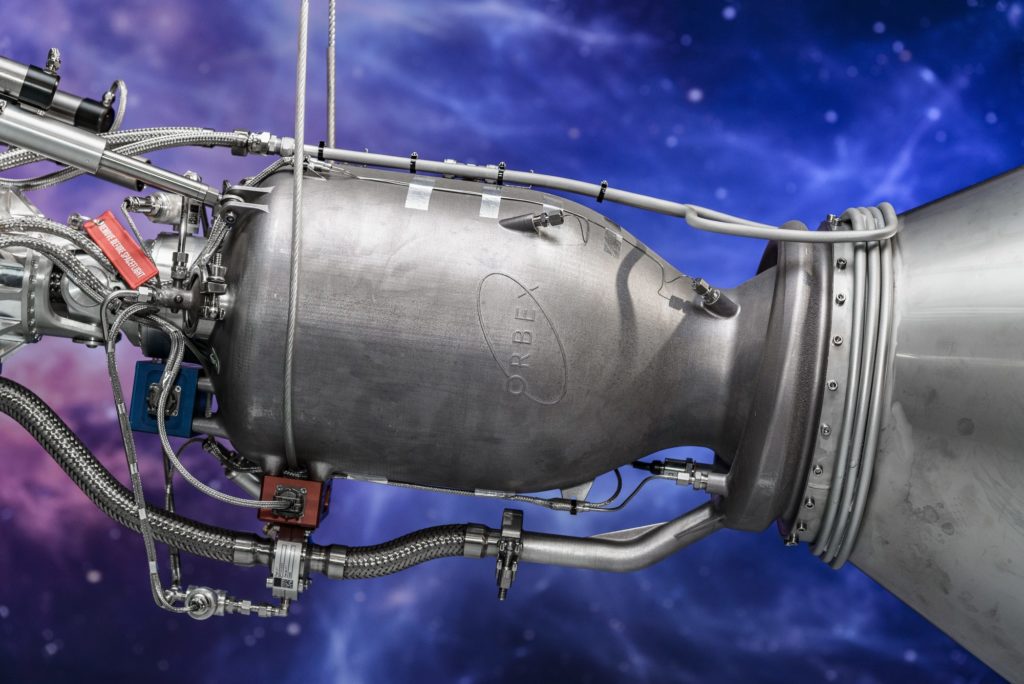Private launch service provider Orbex is getting ready to send its first rockets to polar orbit in 2022. During the past five years, the innovative UK startup has been developing its flagship vertical launch vehicle Orbex Prime and one of the world’s largest 3D printed rocket engines to propel it. With six launch contracts already lined up, Orbex continues to scale up the fabrication of its rocket technology and has announced the commission of the largest industrial 3D printer in Europe for rapid rocket-building. Weighing over 12 metric tonnes, the system will be capable of printing 35 rocket engines and turbopumps every year in-house.
Orbex asked Additive Manufacturing Customized Machines (AMCM) to build the bespoke large volume 3D printing system for creating rocket parts with a custom blend of metals, including titanium and aluminum. The lightweight design of the components will be capable of withstanding extreme temperatures and pressure fluctuations of spaceflight. Orbex expects to print parts (such as rocket engines) in a single piece without joints, seams, or welds to eliminate the weaknesses that can arise from joining and welding parts.
The 3D printed parts will be critical to Orbex’s innovative 19-meter long “micro launcher” rocket, designed to deliver small satellites into polar orbits around the Earth without leaving any debris in the ocean or orbit. Ideal for commercial use, Orbex Prime was conceived and developed as an environmentally sustainable launch system fueled by clean-burning and renewable biopropane. The fuel source, supplied by Orbex’s new exclusive BioLPG fuel partner Calor, cuts carbon emissions by 90% compared to traditional fossil hydrocarbons. The Prime vehicle was designed as a reusable rocket, incorporating a novel recovery and reusability system.
“Although our rocket engines and other critical systems are already quite mature after years of testing, a large-scale in-house 3D printing system like this gives us far greater speed and agility as we ramp up production,” said Orbex CEO Chris Larmour. “It means we can continue to iterate and drive up performance even further. Longer-term, as we get ready for multiple launches per year, it will give us greater control over our costs and supply chain. After exhaustive trials, the results we’ve seen from AMCM were very successful, and we’re confident that we’ve made the right choice of partner.”
The company is not new to 3D printing. Orbex aerospace engineers have used additive manufacturing (AM) for almost the entire propulsion subsystem and carbon fiber and graphene composites for the main structures and tanks. Unveiled publicly in early 2019, its 3D printed rocket engine was uniquely manufactured in a single piece without joins in partnership with metal AM provider SLM Solutions. The company later carried out a series of successful trials with AMCM printing various large-scale rocket components over several months, eventually leading to the multi-million pound deal for the newly commissioned 3D system.
AMCM will deliver a complete printing suite with post-processing machinery and “Machine Vision” systems ideal for automatic imaging-based inspection of printed components and enabling 3D printing machine users to accurately test and qualify printed parts for space applications. To accommodate the new machinery, Orbex is expanding its factory floor space by an additional 1,000 square meters.
The German AM company has helped many space startups and organizations carry out their vision. For example, by providing customized, large-scale AM systems for U.S.-based Launcher Space and high productivity AM systems for the Ariane Group, a European leader of space launchers.
“Investing in a large-scale 3D printing system like this says a lot about Orbex’s ambition in the European spaceflight sector,” commented Martin Bullemer, Managing Director of AMCM. “If they are to lead the European market, they need the product reliability and speed that a large-scale 3D printing system like this will give them. And although this is a major purchase, it will allow for significant cost control for Orbex in the years to come.”
The newly commissioned platform was announced two months after Orbex secured $24 million in a funding round led by BGF, the UK’s most active investment company, and Octopus Ventures, one of the largest venture capital firms in Europe. The new investments secured the roadmap to the first launch from the Space Hub Sutherland spaceport in Scotland and are undeniably being used to maintain a rapid manufacturing pace. The funding is in line with Scotland’s plans to secure a £4 billion slice of the global space market by 2030. An ambitious target that could help build an innovative new industry for Scotland’s economy.
Orbex Prime’s maiden flight will be the first to take off from the Space Hub Sutherland spaceport, which will begin construction sometime in 2021, near Melness on Scotland’s northern coast. Orbex is also completing the detailed scoping of its launch site installation and launch preparation team at the Space Hub. The recently granted Highland Council’s approval of the spaceport has been a landmark in European spaceflight history. It will place the community around the Scottish Highlands Region of Tongue, Melness, and Skerray and the UK at the very heart of the continent’s space launch industry.
